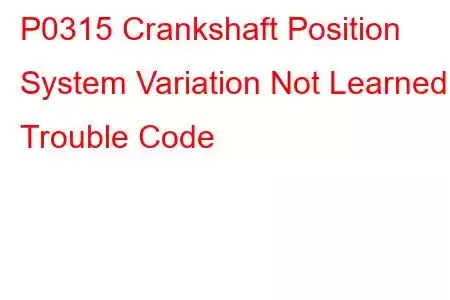P0315 Crankshaft Position System Variation Not Learned
OBD-II Trouble Code Technical Description
Crankshaft Position System Variation Not Learned
What does that mean?
This generic powertrain/engine diagnostic trouble code typically applies to fuel injected engines from most manufacturers since 2003.
Those manufacturers include but are not limited to Dodge, Chrysler, Ford, Jeep, Mazda, Mitsubishi, Kia, Isuzu, and Hyundai.
This code is focused on the relationship between the crankshaft position sensor (CPS) and the engine controller (ECM/PCM). The PCM measures the variation between crankshaft position reference points. These measurements are compared to an ideal reference stored in the PCM. If the variation exceeds a calibrated percentage, a fault code is stored. This is typically an electrical circuit fault, although mechanical issues can affect this code, depending upon vehicle manufacturer.
Troubleshooting steps may vary depending upon vehicle manufacturer and the type of crankshaft position sensor (CPS) and wire colors.
Symptoms
Symptoms of a P0315 engine code may include:
Malfunction Indicator Lamp (MIL) on Misfire / bucking or surging Dies out, but may restart if the problem is inconsistent May run fine, until it is restarted; then will not restart Engine will crank over, but will not runCauses
Typically, the causes for this code to set are:
Crankshaft position re-learn procedure not performed / improperly performed – one of the more common causes Worn timing components, to include the timing chain and timing gears, distributor or even the flex plate (the part that the starter uses to crank the engine over with) – next most common, along with: Faulty Crankshaft Position Sensor – common failure point Open in the power or ground circuit to the crankshaft position sensor Open in the signal circuit between the crankshaft position sensor and the PCM Failed PCM - rarelyDiagnostic Steps and Repair Information
A good starting point is always to check for technical service bulletins (TSB) for your particular vehicle. Your issue may be a known issue with a known fix put out by the manufacturer and can save you time and money during diagnosis.
After that, if you have a scan tool, note all diagnostic trouble codes that are set along with the P0315. Next, clear all diagnostic trouble codes and see if the P0315 returns. If it does not, then the problem was intermittent or the P0315 was a memory code, that is it was something in the past.
If the code resets, that is comes right back the next time you start or try to start the engine, or the very next road test further inspection is required. Locate the Crankshaft Position Sensor on your particular vehicle. Once located, visually inspect the connectors and wiring. Look for chafing, rubbing, bare wires, burn spots or melted plastic. Pull the connectors apart and carefully inspect the terminals (the metal parts) inside the connectors. See if they look corroded, burnt or there is green funk in place of the normal metal color you are probably used to seeing. You can get some Electrical Contact cleaner and a plastic bristle brush at any parts store if you need to clean the terminals. If this is not possible, find some rubbing alcohol and a toothbrush to clean them with, just make sure you do not put the toothbrush back in the bathroom! Afterwards let them air dry, get some dielectric silicone compound (same stuff they use for light bulb sockets) and put some where the terminals come into contact.
Clear the diagnostic trouble codes from memory again, and see if this code returns. If it does not, then the connections were most likely your problem.
If the code does return, remove the Crankshaft Position Sensor from the engine. Look at the end of the sensor where it comes close to the timing components / flex plate / flywheel on t
Read: 38


